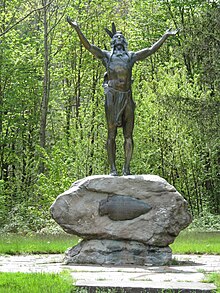Hail to the Sunrise
 The statue on the rock pedestal | |
 | |
| 42°38′23.14″N 72°54′47.85″W / 42.6397611°N 72.9132917°W | |
| Location | Mohawk Park, Charlemont, Massachusetts |
|---|---|
| Designer | Joseph Pollia |
| Material | Bronze |
| Completion date | 1932 |
| Dedicated to | The Mohawk nations of Massachusetts and New York |
Hail to the Sunrise is the name of a monument in Charlemont, Massachusetts, United States. The monument features a prominent statue of a Mohawk warrior and the Max Eninger Memorial Pool. Completed in 1932 by the Improved Order of Red Men, it is a major feature of Mohawk Park, a roadside park located beside Massachusetts Route 2, the Mohawk Trail.[1]
Sculpture
[edit]The bronze statue depicts a Native American man in traditional wardrobe looking eastward with his arms extended. He faces the direction of the rising sun and is said to be greeting the Great Spirit. The casting stands upon a large boulder. A tablet in the shape of an arrowhead at the base of the statue reads: "Hail to the Sunrise - In Memory of the Mohawk Indian."
The pool is lined with 100 inscribed stones from various tribes and councils of the Red Men (the oldest fraternal organization to be granted a charter by Congress) and Degree of Pocahontas, the women's auxiliary, from throughout the United States. Stones of past and present members of the organization line the walkway around the pool.
History
[edit]The Red Men are a fraternal organization who, despite their name, consisted of only white members at the time.[2][3] The statue they commissioned was created by sculptor Joseph Pollia and revealed on October 1, 1932.[4] More than 2,000 people attended the ceremony. The monument honors the peoples of the five Mohawk Nations that inhabited western Massachusetts and New York State.[5] The Mohawks that traveled this trail were said to be friendly to white settlers according to the plaque.[6] However, this area was historically inhabited by the Mohicans, rather than the Mohawk.[7]
The grounds are open to the public and it remains a popular rest stop along the scenic highway. The park also serves as the site of an annual parade and ceremony hosted by the Red men.[1]

See also
[edit]References
[edit]- ^ a b Button, Margaret (September 23, 2022). "8 stops along Massachusetts' Mohawk Trail worth a day trip". The Berkshire Eagle. Retrieved May 2, 2024.
- ^ Deloria, Philip J. (1998). Playing Indian. New Haven, Connecticut: Yale University Press. pp. 59–65.
- ^ Loewen, James W. (1999). Lies Across America: What Our Historic Markers and Monuments Get Wrong. New York: The New Press. pp. 144–147. ISBN 0-684-87067-3.
- ^ Campanile, Robert (2007). Mohawk Trail p. 126. Arcadia Publishing. ISBN 978-0-7385-5007-7.
- ^ Green, Stewart M. (2012). Scenic Routes & Byways New England pp. 109-110. Rowman & Littlefield. ISBN 978-0-7627-8950-4.
- ^ Cook, Greg (July 21, 2009). "Art of the Mohawk Trail". The New England Journal of Aesthetic Research. Retrieved May 2, 2024.
- ^ Noel, Hannah (December 15, 2022). Jochem, Greta (ed.). "Author Q&A: What is deflective whiteness? Why should you care? An MCLA professor breaks down what it is in a new book". The Berkshire Eagle. Retrieved May 2, 2024.
External links
[edit]- Berkshireweb.com: Mohawk Trail Archived 2012-05-28 at the Wayback Machine
- Scenicusa.net: Mohawk Trail Archived 2011-09-17 at the Wayback Machine
- Statues in Massachusetts
- Mohawk culture
- Sculptures of Native Americans in Massachusetts
- Outdoor sculptures in Massachusetts
- Bronze sculptures in Massachusetts
- Buildings and structures in Berkshire County, Massachusetts
- 1932 sculptures
- 1932 establishments in Massachusetts
- Sculptures of men in Massachusetts
- Improved Order of Red Men buildings and structures
- Roadside attractions in Massachusetts
